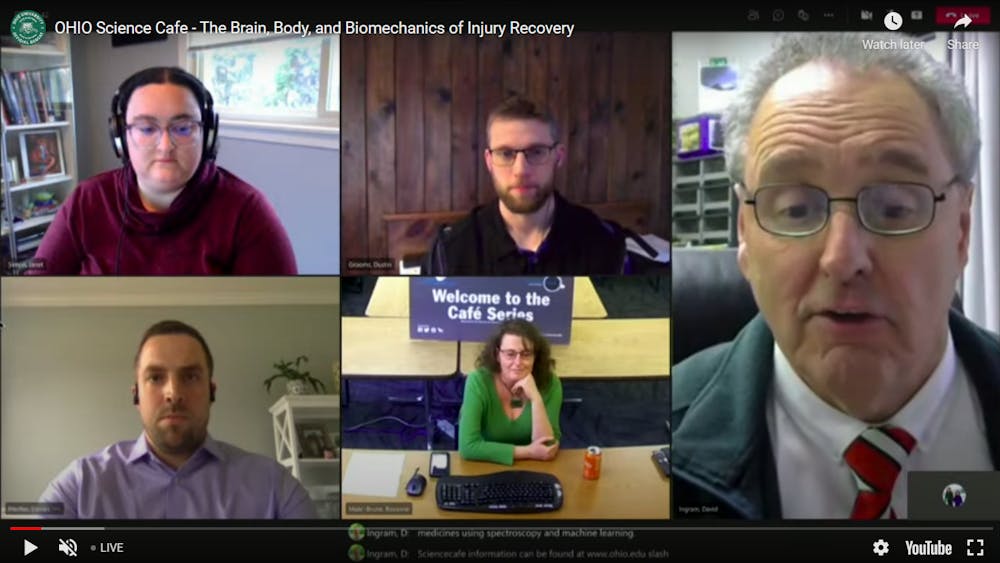Ohio University’s Research Division and OU’s Chapter of Sigma Xi hosted this semester’s second Science Cafe Conversation in the Cafe Conversation Series: “The Brain, Body, and Biomechanics of Injury Recovery.”
The conversation’s focus was primarily on anterior cruciate ligament (ACL) injuries and the rehabilitation process, and was held Wednesday, March 17 on YouTube Live.
The event was moderated by Roxanne Male-Brune, coordinator of the series. All three presenters were from OU’s College of Health Sciences and Professions, including Janet Simon, assistant professor of athletic training, Steven Pfeiffer, assistant professor of musculoskeletal rehabilitation sciences and Dustin Grooms, associate professor of physical therapy.
Simon studied the long-term follow-up of former athletes, finding that after these athletes left the college setting, they struggled with the transition of their bodies from not playing sports regularly. Some were unable to continue physical activity and would develop complications. ACL injuries tend to be somewhat of a hidden issue because people assume athletes are so active.
“I think one of the biggest things is this population that sustains an ACL tear is really young and active,” Simon said. “I think a lot of people don’t think it’s important because they view the return to sport as not a big deal. But, now that we have a lot of data...they’re tracking people years after their ACL tear...and we see that they have really poor outcomes. They do return to sports when they are young, but they are developing osteoarthritis at a young age, decreasing physical activity, which comes with all these other comorbidities such as obesity, diabetes, heart disease, etc. Now we know there are these long term outcomes, we try to develop interventions so we can intervene and hopefully they do not develop these long term outcomes.”
Simon started off the lecture by breaking down the basics of ACL injuries and why it is so important for us to be educated on this topic.
The ACL connects the femur (thigh bone) to the tibia (shin bone) and its main function is to stabilize the knee. There are 200,000 ACL injuries annually in the United States, with 1 in 60 adolescents suffering from this injury every year, the lecturers said. They also said ACL injuries account for $3 billion a year in healthcare costs.
Pfeiffer went more into detail about the biomechanics of the ACL injury, discussing the long-term effects that ACL injuries can have on the body. He specifically talked about osteoarthritis, or inflammation of the joints, which affects over 30 million Americans and is the 11th leading cause of disability in the world. Pfeiffer said that 50% of those who injure their ACL will develop osteoarthritis within 10 years after reconstruction.
Pfeiffer said that collectively as a research body, what is important is building toward education of the public.
“It is a hope of mine...that this kind of research in whatever way possible is able to be known better by our public, so that we can start to educate the public on something that...is a multi-billionaire dollar issue annually in our country,” Pfeiffer said. “It is insane. I think education for the public is a huge thing that I hope we’re able to continue to build on.”
Grooms continued the conversation on ACLs, discussing how the brain changes when a person injures their ACL. He also spoke on how important it is to understand the brain and how it relates to our movement and to measure the brain after injury to help develop the most efficient solutions for rehabbing ACL injuries.
Grooms said he was inspired to make researching ACLs his life mission after he was a clinician training D-3 college athletes, providing by-the-book treatment and rehabilitation to patients with ACL injuries. They would be succeeding, he would sign off, and then within weeks, they would re-injure themselves. He could not figure out what he was doing wrong and felt like he was continuously failing his patients, so he decided to dedicate his life to researching ACLs and advancements in rehabilitation.
One advance mentioned was virtual reality training being used in lieu of traditional physical therapy. Another advancement is augmented reality training, which is in the research development phases to be used to prevent ACL tears by training people to be more aware of their movement. Another option currently being researched is stroboscopic training, which targets neurologic changes in the brain from ACL tears.
“We’re actually working with a company to make a smartphone app where it’s going to take all the stuff we’ve developed, put it in an app, and clinicians can just use it instantly,” Grooms said. “So we’re really happy to change clinical practice with this sort of technology.”
Male-Brune admires how the three researchers are using their clinical backgrounds to come up with new findings.
“They are amazing mentors for students and have a tremendous number of students who come through their labs, learn about the research and science and then go out and apply it to patients,” Male-Brune said. “I think that’s pretty wonderful.”
Previous Science Cafe Conversations are available on the Science Cafe’s website to watch at any time, including the “Brain, Body, and Biomechanics of Injury Recovery” video. The next event will be held virtually on Wednesday, March 24, when Pete Harrington, a chemistry and biochemistry professor, will be speaking about “Chemotyping Natural Medicines Using Spectroscopy and Machine Learning.”






